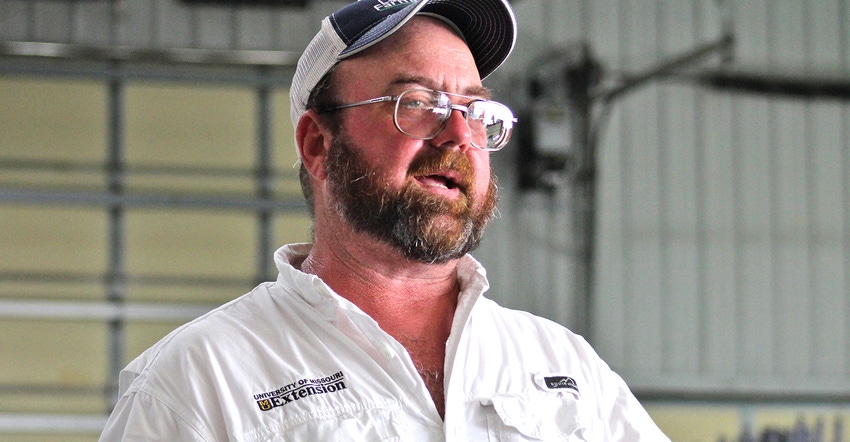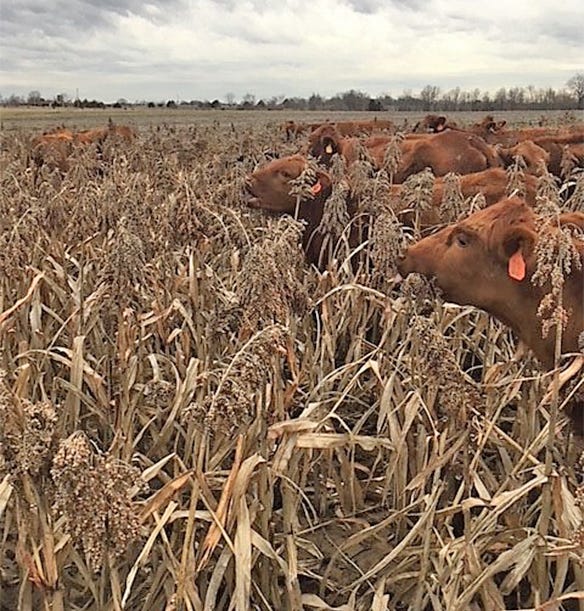
Planting milo for strip-grazing as winter feed is a novel idea for many livestock producers, and one that comes with many questions.
Rusty Lee is a big proponent of the system, but as he says, “Is it all unicorns and rainbows? No.” Farmers peppered the University of Missouri Extension agronomist with questions during the Lincoln County Soil Health Workshop.
Here are Lee’s answers to questions surrounding producing and grazing milo for winter feed:

HEAD HIGH: Cows eat the tops of milo heads. MU Extension agronomist Rusty Lee says cattle don’t mind going into fields with tall milo plants because they can see over the top. He adds they are relaxed and calm when grazing.

Is there added labor with grazing milo? You will move wire every day, no matter what. So, prepare to spend a few more minutes on chores. But it can be done by one person.
What are field conditions like after the cows graze? If the ground is not frozen, you are going to destroy the footprint when it is soft and wet. It is rough looking. But if my cows are not doing this to my crop field, they would be doing it to the pasture. You are going to find a sacrificial lot to feed hay in. I would rather get my crop field back into shape with tillage than try to bring back my pasture.
Will strip-grazing milo work with calves? My field has fall calving cows. The calves are along for the ride. The calves stay out of the field until after the mad rush is over when the gate is first opened. Pretty soon, the calves are watching mama, then they will start in on eating. It is a pretty neat program.
Should cattle producers worry about nitrates? I haven’t seen or heard of it being an issue grazing milo the way we are doing it. You could increase the potential for a problem with overfertilization. We are going for 120-bushel milo. There is no need for 120 pounds of nitrogen on it.
What about prussic acid? Milo is safe when grazing green, but for seven to 10 days after first fall frost your cattle must be removed. After that time, prussic acid should not be an issue for the rest of the winter.
What is the best type of land to use in this system? Some guys say, “Don’t take the good ground, take the marginal ground.” But you need grain yield. Still, milo has a better chance making grain yield on marginal ground. It likes it hot and dry. Really, it is about what land has access to water for livestock and will work in your operation.
Can you plant and strip-graze the same field year after year? I have one field in continuous milo for three years. It is going to make Year 4. We worry about herbicide-resistant weeds but haven’t noticed any issues. It is a field that works out handy with winter stock water and loafing areas.
What type of fence charger works best? Don’t skimp on your fence charger. We have a grazing system perimeter electric fence 110-volt plug-in with a heavy joule that we tap into. What makes this a whole lot easier is I have a fence with a fault finder with a remote-control shutoff. I turn it off, roll out the wire, give access to the cows and make it hot with the remote before they get to the other end. Make sure fence chargers are grounded right using multiple grounding rods. You can use solar power but shoot for at least a 2-joule electric fence with two batteries for backup.
Does this work just for cattle? It really works well with sheep. The difference is you do not have to strip-graze sheep in a field of milo. You can put them in 10 acres, and they only eat around the outside edges. Sheep, if they walk in, lose all vision. They lose sight of predators. So, sheep don’t go to the interior, they stay on the outside and work their way to center.
About the Author(s)
You May Also Like






